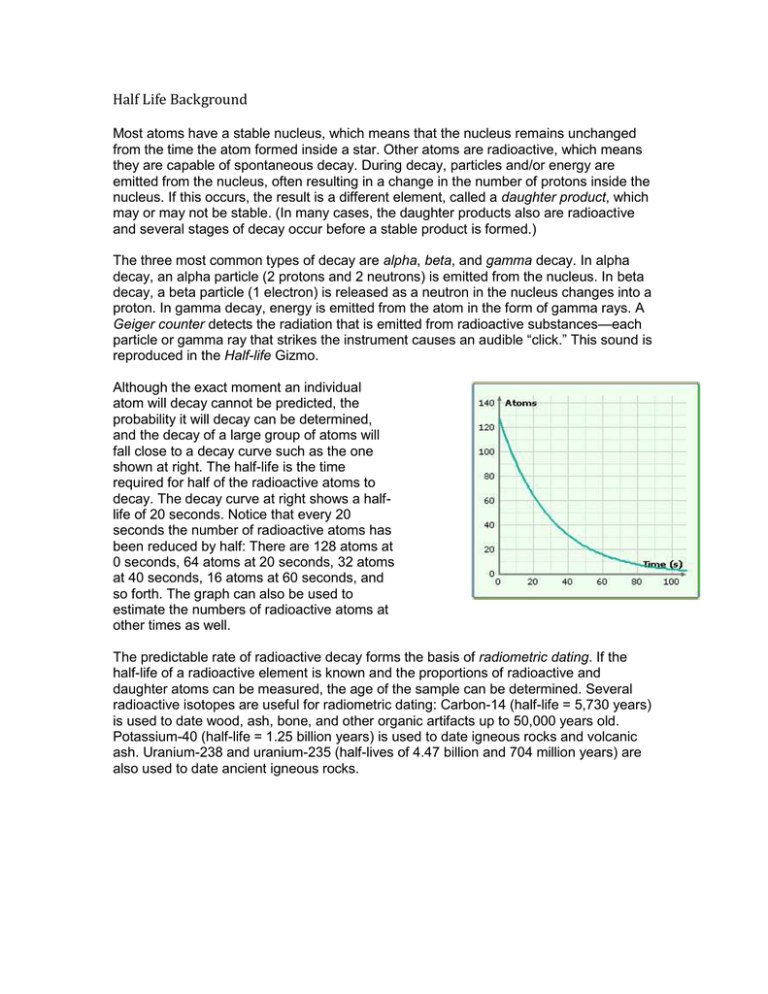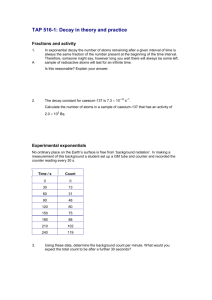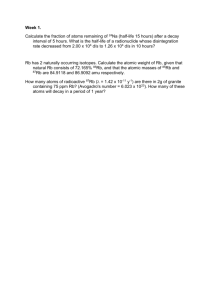Half Life Background - LunsfordIntegratedScience
advertisement

Half Life Background Most atoms have a stable nucleus, which means that the nucleus remains unchanged from the time the atom formed inside a star. Other atoms are radioactive, which means they are capable of spontaneous decay. During decay, particles and/or energy are emitted from the nucleus, often resulting in a change in the number of protons inside the nucleus. If this occurs, the result is a different element, called a daughter product, which may or may not be stable. (In many cases, the daughter products also are radioactive and several stages of decay occur before a stable product is formed.) The three most common types of decay are alpha, beta, and gamma decay. In alpha decay, an alpha particle (2 protons and 2 neutrons) is emitted from the nucleus. In beta decay, a beta particle (1 electron) is released as a neutron in the nucleus changes into a proton. In gamma decay, energy is emitted from the atom in the form of gamma rays. A Geiger counter detects the radiation that is emitted from radioactive substances—each particle or gamma ray that strikes the instrument causes an audible “click.” This sound is reproduced in the Half-life Gizmo. Although the exact moment an individual atom will decay cannot be predicted, the probability it will decay can be determined, and the decay of a large group of atoms will fall close to a decay curve such as the one shown at right. The half-life is the time required for half of the radioactive atoms to decay. The decay curve at right shows a halflife of 20 seconds. Notice that every 20 seconds the number of radioactive atoms has been reduced by half: There are 128 atoms at 0 seconds, 64 atoms at 20 seconds, 32 atoms at 40 seconds, 16 atoms at 60 seconds, and so forth. The graph can also be used to estimate the numbers of radioactive atoms at other times as well. The predictable rate of radioactive decay forms the basis of radiometric dating. If the half-life of a radioactive element is known and the proportions of radioactive and daughter atoms can be measured, the age of the sample can be determined. Several radioactive isotopes are useful for radiometric dating: Carbon-14 (half-life = 5,730 years) is used to date wood, ash, bone, and other organic artifacts up to 50,000 years old. Potassium-40 (half-life = 1.25 billion years) is used to date igneous rocks and volcanic ash. Uranium-238 and uranium-235 (half-lives of 4.47 billion and 704 million years) are also used to date ancient igneous rocks.







